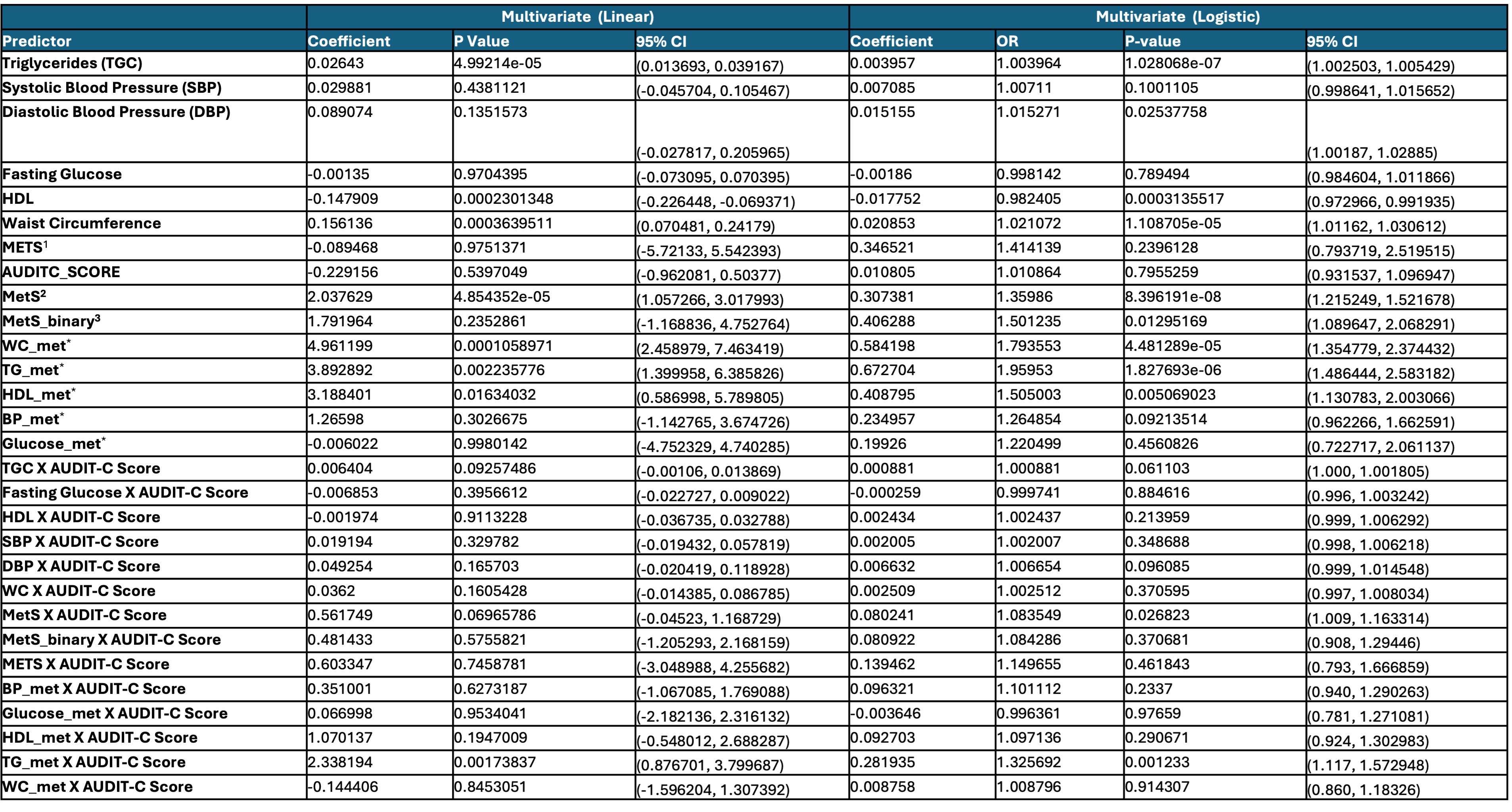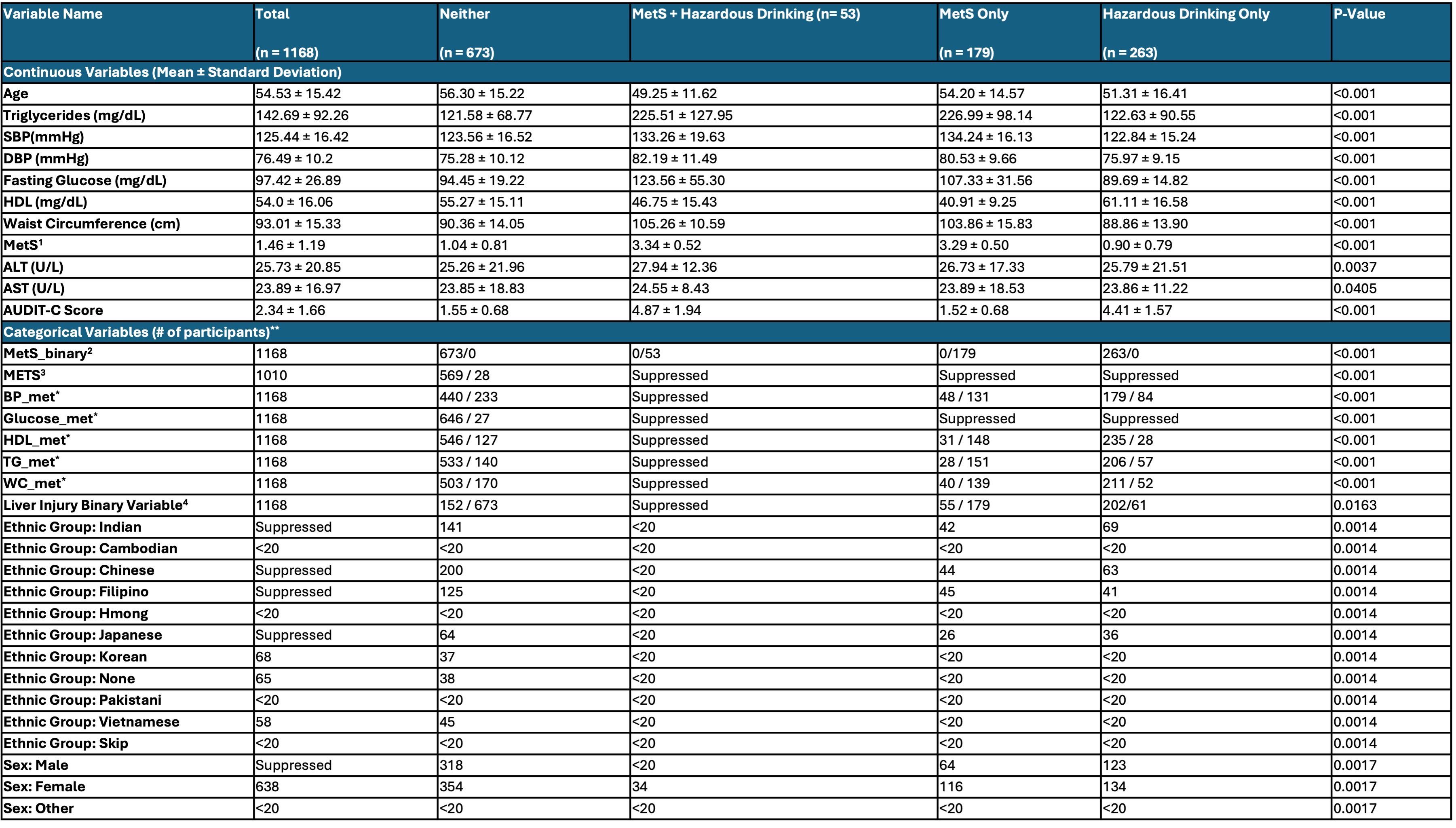Tuesday Poster Session
Category: Liver
P5847 - Interaction of Metabolic Syndrome and Alcohol Consumption on Liver Injury in Asian Americans
Tuesday, October 28, 2025
10:30 AM - 4:00 PM PDT
Location: Exhibit Hall

Kerry Y. Lee, MS (he/him/his)
Virginia Commonwealth University School of Medicine
Richmond, VA
Presenting Author(s)
Kerry Y. Lee, MS1, Ye In Christopher Kwon, BA1, Matthew Ambrosio, MS2, Nicole Ng, MD3
1Virginia Commonwealth University School of Medicine, Richmond, VA; 2Virginia Commonwealth University Department of Biostatistics; Pauley Heart Center, Richmond, VA; 3NewYork-Presbyterian Hospital/Weill Cornell Medical Center, New York, NY
Introduction: The combined effects of alcohol use and Metabolic Syndrome (MetS) on liver injury remain understudied, particularly in Asian Americans (AA). This study examined the potential synergistic effects of alcohol and MetS on liver injury using the NIH All of Us (AoU) database.
Methods: We conducted a cross-sectional analysis of Asian American adults ( > 21 years old) from the AoU database, including data on triglycerides (TG), HDL, SBP, DBP, fasting blood glucose (FBG), waist circumference (WC), alcohol use (AUDIT-C score), and liver enzymes (ALT, AST). MetS was assessed using ATP III criteria, represented categorically (MetS_binary, ≥ 3 criteria), diagnostically (METS code), and as a severity score (Met_S, 0-5). Participants were divided into 4 groups based on MetS and hazardous drinking (AUDIT-C Score ≥ 4 in males or ≥ 3 in females): MetS only, hazardous drinking only, both, or neither. The primary outcomes were ALT levels and presence of liver injury as defined by ALT > 33 U/L for men or > 25 U/L for women. Logistic and linear regression models for each predictor were performed, and adjusted for age and sex.
Results: Of the 1,168 participants, 15.3% had MetS only, 22.5% had hazardous drinking only, and 4.5% had both; age, sex, ethnicity, ALT levels, and presence of liver injury were different between groups (p < 0.05). Regression analyses indicated that higher TG and WC, and lower HDL, individually increased odds of liver injury and were associated with higher ALT levels. MetS (MetS_binary) conferred a 50% increased odds of liver injury (OR 1.50; CI 1.09-2.07, p=0.01), and increase in MetS severity score was associated with a 36% higher odds of liver injury (OR 1.36; CI 1.22-1.52, p< 0.001). There was a significant interaction between MetS severity and AUDIT-C score (OR 1.08; CI 1.01-1.16, p=0.03); however, AUDIT-C score alone was not significantly associated with liver injury (OR 1.01; CI 0.93-1.10, p=0.80) or ALT levels (Coefficient: -0.23, p=0.54).
Discussion: Our findings highlight a synergistic impact of alcohol use and MetS severity on liver injury among AA. Although alcohol use does not independently predict liver injury risk in our cohort, it may be due to generally low alcohol use in the cohort (mean AUDIT-C = 2.34). This highlights the importance of evaluating both metabolic and alcohol-related risk factors in assessing liver injury and disease risk in AA populations. Future studies should prioritize data disaggregation to identify specific risk profiles among Asian ethnic groups.

Figure: Table #1: Demographic and Metabolic Characteristics Across Four Groups Defined by Metabolic Syndrome and Hazardous Drinking.
1 MetS represents a Severity Score ranging from 0-5, based on # of ATP III criteria met.
2 MetS_binary represents whether a participant meets >= 3/5 ATP III Criteria based on available lab data.
3 METS represents whether a participant was diagnosed with MetS based on diagnostic code.
4 Liver Injury Binary Variable represents if participants meet the following criteria: ALT > 33 in men >25 in women.
* all _met variables are binary variables representing whether participants meet the corresponding criteria in the ATP III criteria (Ex: TG_met = 1 if TG > 150 mg/dL). For binary variables, the first number represents number of participants not meeting criteria, and the second number represents number of participants meeting the criteria (Ex: 50/20 means 50 participants do not meet the criteria, and 20 participants meet the criteria).
Note: For cells that have <20 or suppressed, this was done to comply with the All of Us Data and Statistics Dissemination Policy for group counts between 1-20.

Figure: Table #2: Multivariate Linear and Logistic Regression Analysis of Each Predictor Independently and its Interaction with Alcohol Use on Liver Injury.
1 METS represents whether a participant was diagnosed with MetS based on diagnostic code.
2 MetS represents a Severity Score ranging from 0-5, based on # of ATP III criteria met.
3 MetS_binary represents whether a participant meets >= 3/5 ATP III Criteria based on available lab data.
*all _met variables are binary variables representing whether participants meet the corresponding criteria in the ATP III criteria (Ex: TG_met = 1 if TG > 150 mg/dL).
OR = Odds Ratio, CI = Confidence Interval
Disclosures:
Kerry Lee indicated no relevant financial relationships.
Ye In Christopher Kwon indicated no relevant financial relationships.
Matthew Ambrosio indicated no relevant financial relationships.
Nicole Ng indicated no relevant financial relationships.
Kerry Y. Lee, MS1, Ye In Christopher Kwon, BA1, Matthew Ambrosio, MS2, Nicole Ng, MD3. P5847 - Interaction of Metabolic Syndrome and Alcohol Consumption on Liver Injury in Asian Americans, ACG 2025 Annual Scientific Meeting Abstracts. Phoenix, AZ: American College of Gastroenterology.
1Virginia Commonwealth University School of Medicine, Richmond, VA; 2Virginia Commonwealth University Department of Biostatistics; Pauley Heart Center, Richmond, VA; 3NewYork-Presbyterian Hospital/Weill Cornell Medical Center, New York, NY
Introduction: The combined effects of alcohol use and Metabolic Syndrome (MetS) on liver injury remain understudied, particularly in Asian Americans (AA). This study examined the potential synergistic effects of alcohol and MetS on liver injury using the NIH All of Us (AoU) database.
Methods: We conducted a cross-sectional analysis of Asian American adults ( > 21 years old) from the AoU database, including data on triglycerides (TG), HDL, SBP, DBP, fasting blood glucose (FBG), waist circumference (WC), alcohol use (AUDIT-C score), and liver enzymes (ALT, AST). MetS was assessed using ATP III criteria, represented categorically (MetS_binary, ≥ 3 criteria), diagnostically (METS code), and as a severity score (Met_S, 0-5). Participants were divided into 4 groups based on MetS and hazardous drinking (AUDIT-C Score ≥ 4 in males or ≥ 3 in females): MetS only, hazardous drinking only, both, or neither. The primary outcomes were ALT levels and presence of liver injury as defined by ALT > 33 U/L for men or > 25 U/L for women. Logistic and linear regression models for each predictor were performed, and adjusted for age and sex.
Results: Of the 1,168 participants, 15.3% had MetS only, 22.5% had hazardous drinking only, and 4.5% had both; age, sex, ethnicity, ALT levels, and presence of liver injury were different between groups (p < 0.05). Regression analyses indicated that higher TG and WC, and lower HDL, individually increased odds of liver injury and were associated with higher ALT levels. MetS (MetS_binary) conferred a 50% increased odds of liver injury (OR 1.50; CI 1.09-2.07, p=0.01), and increase in MetS severity score was associated with a 36% higher odds of liver injury (OR 1.36; CI 1.22-1.52, p< 0.001). There was a significant interaction between MetS severity and AUDIT-C score (OR 1.08; CI 1.01-1.16, p=0.03); however, AUDIT-C score alone was not significantly associated with liver injury (OR 1.01; CI 0.93-1.10, p=0.80) or ALT levels (Coefficient: -0.23, p=0.54).
Discussion: Our findings highlight a synergistic impact of alcohol use and MetS severity on liver injury among AA. Although alcohol use does not independently predict liver injury risk in our cohort, it may be due to generally low alcohol use in the cohort (mean AUDIT-C = 2.34). This highlights the importance of evaluating both metabolic and alcohol-related risk factors in assessing liver injury and disease risk in AA populations. Future studies should prioritize data disaggregation to identify specific risk profiles among Asian ethnic groups.

Figure: Table #1: Demographic and Metabolic Characteristics Across Four Groups Defined by Metabolic Syndrome and Hazardous Drinking.
1 MetS represents a Severity Score ranging from 0-5, based on # of ATP III criteria met.
2 MetS_binary represents whether a participant meets >= 3/5 ATP III Criteria based on available lab data.
3 METS represents whether a participant was diagnosed with MetS based on diagnostic code.
4 Liver Injury Binary Variable represents if participants meet the following criteria: ALT > 33 in men >25 in women.
* all _met variables are binary variables representing whether participants meet the corresponding criteria in the ATP III criteria (Ex: TG_met = 1 if TG > 150 mg/dL). For binary variables, the first number represents number of participants not meeting criteria, and the second number represents number of participants meeting the criteria (Ex: 50/20 means 50 participants do not meet the criteria, and 20 participants meet the criteria).
Note: For cells that have <20 or suppressed, this was done to comply with the All of Us Data and Statistics Dissemination Policy for group counts between 1-20.

Figure: Table #2: Multivariate Linear and Logistic Regression Analysis of Each Predictor Independently and its Interaction with Alcohol Use on Liver Injury.
1 METS represents whether a participant was diagnosed with MetS based on diagnostic code.
2 MetS represents a Severity Score ranging from 0-5, based on # of ATP III criteria met.
3 MetS_binary represents whether a participant meets >= 3/5 ATP III Criteria based on available lab data.
*all _met variables are binary variables representing whether participants meet the corresponding criteria in the ATP III criteria (Ex: TG_met = 1 if TG > 150 mg/dL).
OR = Odds Ratio, CI = Confidence Interval
Disclosures:
Kerry Lee indicated no relevant financial relationships.
Ye In Christopher Kwon indicated no relevant financial relationships.
Matthew Ambrosio indicated no relevant financial relationships.
Nicole Ng indicated no relevant financial relationships.
Kerry Y. Lee, MS1, Ye In Christopher Kwon, BA1, Matthew Ambrosio, MS2, Nicole Ng, MD3. P5847 - Interaction of Metabolic Syndrome and Alcohol Consumption on Liver Injury in Asian Americans, ACG 2025 Annual Scientific Meeting Abstracts. Phoenix, AZ: American College of Gastroenterology.

